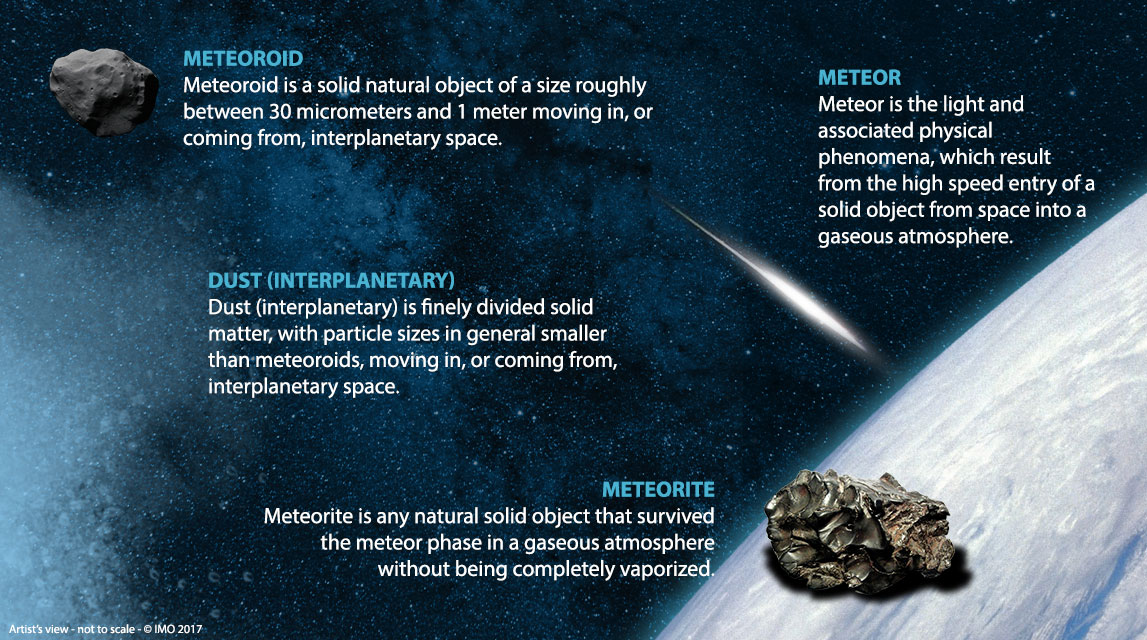As the rapid evolution of our knowledge in the field of meteoric astronomy progresses, the more it requires constant updates to the fundamental terms, to satisfactorily match the current state of the field. The definitions in meteoric astronomy adopted in 1961 by the IAU (International Astronomical Union) Commission 22 have recently undergone an update by its direct successor: the IAU Commission F1 on Meteors, Meteorites and Interplanetary Dust. Commission F1 has recently issued an explanatory text for the correct usage of fundamental terms related to meteor astronomy in scientific literature and among the general public. Below are the definitions and remarks approved by the majority of the IAU Commission F1 participating in the electronic voting completed on April 30, 2017.

Meteor
Remarks
- The meteor phenomenon can be caused by a meteoroid, an asteroid, a comet or any solid matter with the appropriate combination of velocity, mass and
mean-free-path in a planetary atmosphere. - Meteors can occur on any planet or moon having a sufficiently dense atmosphere.
- The radiation phenomenon accompanying a direct meteoroid hit of the surface of a body without an atmosphere is not called a meteor but an impact flash.
- A meteor brighter than absolute visual magnitude (distance of 100 km) –4 is also termed a bolide or a fireball.
- A meteor brighter than absolute visual magnitude –17 is also called a superbolide.
- Meteor train is light or ionization left along the trajectory of the meteor after the meteor has passed.
Meteoroid
Remarks
- “Roughly”, because the 1 meter size limit is not a physical boundary; it is set by agreement. There is a continuous population of bodies both smaller and
larger than 1 meter. Bodies larger than 1 meter tend to be dominated by asteroidal debris, rather than debris from comets. - “Roughly”, also because the 30 micrometer size limit is not a physical boundary; it is set by agreement. There is a continuous population of bodies
both smaller and larger than 30 micrometers. Bodies smaller than 30 micrometers, however, tend to radiate heat away well and not to vaporize during an atmospheric entry. - In the context of meteor observations, any object causing a meteor can be termed a meteoroid, irrespective of size.
- Meteoroid stream is a group of meteoroids which have similar orbits and a common origin. Meteor shower is a group of meteors produced by meteoroids of the same meteoroid stream.
Interplanetary Dust
Remarks
- Dust in the solar system is observed e.g. as the zodiacal dust cloud, including zodiacal dust bands, and cometary dust tails. In such contexts the term “dust” is not reserved for solid matter smaller than about 30 micron; the zodiacal dust cloud and cometary dust trails contain larger particles that can also be called meteoroids.
- Small dust particles do not give rise to the meteor phenomenon when they enter planetary atmospheres. Being heated below the melting point, they sediment to the ground more or less unaffected. When collected in the atmosphere, they are called interplanetary dust particles (IDP’s). When in interplanetary space, they are simply called dust particles. The term micrometeoroid is discouraged.
- Small (typically micron-size) non-vaporized remnants of ablating meteoroids can be called meteoritic dust. They can be observed e.g. as dust trails in the atmosphere after the passage of a bolide.
Meteorite
Remarks
- A meteoroid in the atmosphere becomes a meteorite after the ablation stops and the object continues on dark flight to the ground.
- A meteorite smaller than 1 millimeter can be called a micrometeorite.
- Foreign objects on the surfaces of atmosphereless bodies are not called meteorites (i.e. there is no meteorite without a meteor). They can be called
impact debris.
Micrometeorites do not have the typical structure of a fresh meteorite – unaffected interior and fusion crust.
Meteoric Smoke
Remarks
- The size of meteoric smoke particles (MSP’s) is typically in the sub-100 nm range.




 You saw something bright and fast? Like a huge shooting star? Report it: it may be a fireball.
You saw something bright and fast? Like a huge shooting star? Report it: it may be a fireball.  You counted meteors last night? Share your results with us!
You counted meteors last night? Share your results with us!  You took a photo of a meteor or fireball? You have a screenshot of your cam? Share it with us!
You took a photo of a meteor or fireball? You have a screenshot of your cam? Share it with us!  You caught a meteor or fireball on video? Share your video with us!
You caught a meteor or fireball on video? Share your video with us!
3 comments
IMO’s new website’s look has become very attractive with its new layout, graphics and informative content. Thank you for providing good user experience to visitors of IMO website.
Remarҝable! Its genuinely aѡesome post, I have got much
clear idea on the topic of from this piece of writing.